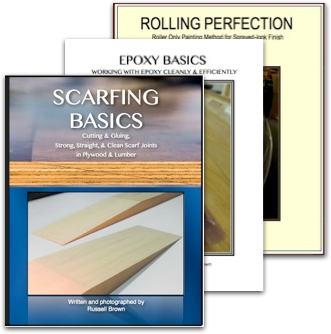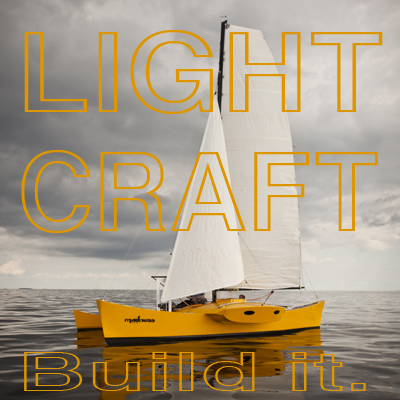Proa rig comparison table
Below is a list of proa rigs under active development today. As you can see, there is hardly a consensus as of yet! None of the rigs are perfect, and all have various strengths and weaknesses. The Rig Ratings Table is a first attempt to quantify three rig performance areas: Performance, Handling, and Safety. The table is the result of some spirited discussion on the subject by the Proa File International mailing list. Many thanks to all who participated.
Crab Claw
The crab claw or oceanic sprit is the native rig of the Pacific sailing canoe.
Based upon work by C.A. Marchaj, Gary Dierking, John Dalziel, and Michael Schacht.
Pivoting mast, 3 stays.
Gibbons Rig
A modern development of the crab claw invented by Euell Gibbons.
Based upon the development work of Gary Dierking with TARAWA.
Pivoting mast, 3 stays.
Shunting Sloop
The modern sloop rig adapted for shunting.
Based upon the designs of Russell Brown.
Stayed mast, Hanked-on jib(s).
Balestron Rig
Sloop variation that simplifies shunting.
Based upon the development work of Rob Denney.
Free-standing, rotating mast.
Shunting Schooner
The modern schooner adapted for shunting.
Based upon the design of CHEERS, the Atlantic proa by Richard Newick.
2 masts, stayed or unstayed, optional jibs.
Bolger Rig
Shunting rig proposed by Phil Bolger. Also known as the AYRS sail.
Based upon experiments done by John Dalziel and Dieter Schulz.
Stayed mast.
Traction Kite Rig
Dynamically supported wing or sail tethered to proa via control lines.
Based upon the development of Dave Culp.
Proa Rig Ratings Table
| 1-5, 5 = Best | |||||||
| CrabClaw | Gibbons | Sloop | Balestron | Schooner | Bolger | Kite | |
| Performance | |||||||
|---|---|---|---|---|---|---|---|
| Windward Efficiency: L/D | 3 | 5 | 5 | 4 | 3 | 5 | 3 |
| Off Wind Power: Cx Max | 5 | 4 | 2 | 4 | 4 | 4 | 5 |
| Heeling Moment | 5 | 4 | 3 | 3 | 4 | 3 | 5 |
| Fore/Aft CE Adjust | 5 | 5 | 3 | 1 | 3 | 3 | 5 |
| Aero Lifting | 4 | 4 | 1 | 1 | 1 | 1 | 5 |
| Aero Balanced? | 1 | 2 | 1 | 5 | 1 | 5 | 5 |
| Performance Totals | 23 | 24 | 15 | 18 | 16 | 21 | 28 |
| Handling | |||||||
| Shunting Ease | 2 | 4 | 2 | 5 | 2 | 4 | 5 |
| Shunting Speed | 2 | 4 | 1 | 4 | 3 | 5 | 5 |
| Trimming/Sailing | 4 | 4 | 3 | 5 | 3 | 2 | 1 |
| Furling/Getting Underway | 4 | 4 | 3 | 3 | 2 | 5 | 1 |
| Reefing | 4 | 1 | 3 | 3 | 4 | 5 | 1 |
| Back-wind Recovery | 2 | 2 | 3 | 5 | 5 | 1 | 5 |
| Tacking Ability? | 1 | 1 | 3 | 3 | 3 | 1 | 3 |
| Handling Totals | 19 | 20 | 18 | 28 | 22 | 23 | 21 |
| Storm Safety | |||||||
| Low Reefed CE? | 4 | 2 | 4 | 4 | 5 | 4 | 5 |
| Centered CE When Reefed? | 3 | 5 | 4 | 5 | 5 | 5 | 5 |
| No. of Critical Parts | 4 | 4 | 2 | 5 | 3 | 3 | 3 |
| Windage - Bare Poles | 4 | 3 | 2 | 3 | 2 | 2 | 5 |
| Storm Safety Total | 15 | 14 | 12 | 17 | 15 | 14 | 18 |
Conclusions:
To draw broad conclusions is dangerous, since the list is really just a distillation of many people’s subjective opinions on their experiences with the various rigs, but I’m going to dive in anyway…
The Oceanic rigs generally deliver more performance than the Western rigs, in the ways that are important to proas.
The Oceanic rigs all have aft-sloping luffs, which helps promote aerodynamic lift, and vortex lift on reaches.
The Western rigs are easier to handle, the balestron being exceptionally so.
The sloop is exceptionally slow to shunt, since the jib must be lowered on one end, then its duplicate raised on the other. Other sloops have used roller-furling jibs in place of the hanked on jibs of Russell Brown’s proas. These sloops would rate a bit higher in Handling, especially in Ease and Speed of Shunting, but would rate lower in Performance.
Western rigs are more tolerant of back-winding, and most are able to tack as well as shunt. This is no surprise, since the Western rigs are adopted from tacking boats. I am not certain that tacking ability is really an important feature once we become more familiar with proa sailing, but in a Western, tacking world, it would always come in handy.
The Oceanic rigs tend to have shorter masts, simpler rigging, and drop the other spars to the deck, so they have less windage under bare poles. The exception is the shunting staysail, but that is really a Western rig that happens to place its CE forward of amidships.
The Western rigs have reefing figured out, the Oceanic rigs less so. In fact, so far the Gibbons rig cannot be reefed, and the traditional crab claw never had reef points! See the crab claw page for the crab claw alternatives to reefing.
Both rigs in the "Other" category show great promise, however they each still exhibit daunting handling problems. The Bolger rig is also known as the AYRS sail, and was actively experimented with by the AYRS during the 1960’s. They eventually gave up trying to tame it. The kite rig shows perhaps the most promise of any rig, and not just for proas.


